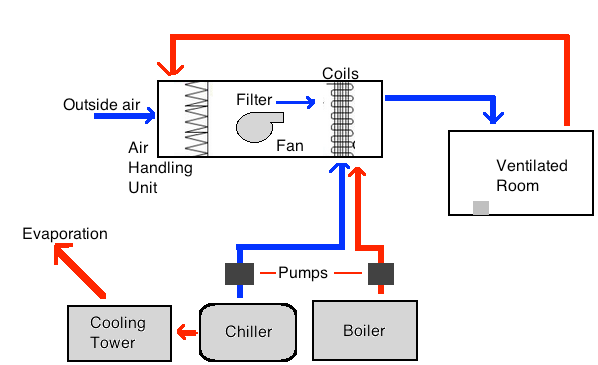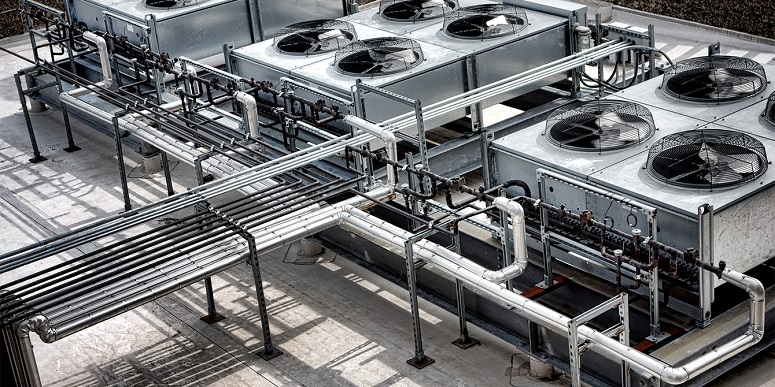HVAC is a term that is heard in all kinds of applications, from domestic to industrial. What it means and where it is used are the things that you might not know. In what follows, you will have access to some information about this subject.
Linquip, as a reliable supplier of various HVAC products, is providing you with the means of finding the right product to fit your needs.
What is HVAC?
HVAC is a term stemmed from ‘Heating, Ventilating, and Air Conditioning’, and it is a system that is aimed to provide comfort for indoor areas. Science contributes to identification of various measures for that comfort and thermal control, and HVAC systems will be engineered based on the desired design points.
Examples of HVAC systems would be those large rooftop boxes (actually compressors) of air conditioners that provide the conditioned air for the interior of the buildings.
The importance of HVAC
As was mentioned earlier, an HVAC system is intended for thermal control of areas as well as comfort for occupants. Temperature is a factor that affects the performance and health status of many systems. Take the case of a server room temperature as an example for which high temperature adversely affects the system’s reliability and operation of the servers is a great source of heat generation; therefore, it is important to have an HVAC system that keeps the temperature at a desired point.
HVAC for temperature control is important for many other applications from domestic and commercial to industrial when it comes to temperature control of unoccupied areas. Now, there is the case with occupied areas for which comfort becomes an important consideration. Comfort is both the temperature and quality of the air in an area where the occupants would comfortably live and work and a good HVAC system is one that provides such comfort.
Different Kinds of HVAC Models
Some HVAC systems are single-staged, including cooling systems, heating systems, ventilation systems, humidifiers and air purifiers. The systems are usually less expensive than those with an integrated set of features, but might also be less efficient and run at unnecessary capacities.
HVAC systems can also be built for a combination of jobs delivered and can also be modeled as zoned systems that provide a variety of configurations for cooling and heating at different designated areas.
Let us not turn our attention to the most significant usages of HVAC systems: cooling and heating.
Cooling systems
Cooling systems range from large air conditioning systems to small portable ones that provide air cooling. These systems come in use for hot climates or spaces. What these systems do is that they pass the air over fluid-cooled surfaces before leading it into the intended area for cooling. The air is exchanges heat with the cooled surface and then is directed to the area delivering its duty.
The cooling fluid could be water or an evaporative fluid. In case of evaporative systems, since the process of evaporation is endothermic, i.e. it absorbs heat, a lot of heat can be absorbed by the evaporator providing high levels of cooling. Of course, such fluids cannot be integrated to all systems due to financial, safety and environmental concerns.
Heating systems
Heating can be done more easily and there are more ways for building a heating system. Heating can be done via electric heating, heat pumps (that could also be used for cooling – more on this in another post), water, steam, and hot gas radiators, etc.
Heating systems could deliver hot air by pushing it passed some hot surface into the intended area for heating, or could be done through thermal radiation from hot surfaces. An efficient way for heating a space would be floor heating through radiation from water or glycol carrying tubes installed below the surface of a floor. Since the hotter air would float above the cooler air and heat source is on the floor, this method would be very efficient.
HVAC System Parts and Diagram

There are different parts for a HVAC system based on its application, but one can consider what occurs in a evaporative cooling system as a widely used case throughout the world and get a sense of what is generally happening in the system. The logic for heating is in a way similar and can be deduced from here. Now, the key components for a cooling system include the expansions valve, evaporator, compressor, condenser, and drier.
The expansion valve induces a pressure drop in the fluid that expands its volume. The evaporator is where the refrigerant fluid absorbs heat through the process of evaporation to cool down the stream entering the warm environment. The compressor is what makes the flow of the refrigerant possible. Condenser is what that rejects the heat into the outside air to and return the refrigerant to its initial state. Receiver drier is where the contaminants are removed from the refrigerant to ensure better air quality.
More on HVAC Systems
To find more details about the fundamentals of how HVAC systems work, you can see this video.
Buy Equipment or Ask for a Service
By using Linquip RFQ Service, you can expect to receive quotations from various suppliers across multiple industries and regions.
Click Here to Request a Quotation From Suppliers and Service Providers
Read More on Linquip




Can you guys make a list of pics with definitions of things like compressors, relays, contactors, etc.?
Very helpful. Takes the mystery out of a system we know little about until it malfunctions.
Cost and service component data for service should help in assessment and negotiations.
Thanks for sharing your experience with us, Robert! You can also visit our industrial directories, where you can find thousands of various industrial equipment based on your application and demand.